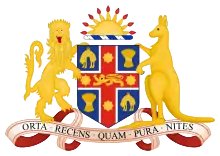Anti-Discrimination Act 1977
The New South Wales Anti-Discrimination Act 1977 is an Act of the NSW Parliament, relating to discrimination in employment, the public education system, delivery of goods and services, and other services such as banking, health care, property and night clubs.
| Anti-Discrimination Act 1977 | |
|---|---|
 | |
| Parliament of New South Wales | |
| |
| Citation | 1977 No 48 |
| Royal assent | 28 April 1977 |
| Commenced | 1 June 1977 |
| Administered by | Department of Justice |
| Legislative history | |
| Bill title | Anti-Discrimination Bill |
| Status: Current legislation | |
The Act prohibits unlawful racial, sexual and other types of discrimination in certain circumstances and promotes equality of opportunity for all people
The Act covers the following types of discrimination:
- Sex (including breastfeeding, pregnancy and sexual harassment)
- Disability (including past, present or future disability and also includes actual or perceived HIV status)
- Race (including ethno-religion)
- Homosexuality (actual or perceived)[1]
- Marital or domestic status
- Age (present or future)
- Transgender (including transsexuality)
- Carer’s responsibilities (but only within employment).
Development of the NSW Anti-Discrimination Act 1977
The Act was granted Royal Assent on 28 April 1977 and came into effect on 1 June 1977. It was the 48th Act of 1977. Since then the Act has been amended and reformed about 90 times.[2][3]
Anti-Discrimination Board of NSW
The Anti-Discrimination Board of NSW was set up under the NSW Anti-Discrimination Act 1977 to promote anti-discrimination and equal opportunity principles and policies throughout NSW and to administer the Act.
Functions of the Board
The Anti-Discrimination Board of NSW handles complaints of discrimination made by members of the public, investigating and conciliating complaints when appropriate.
It also works to prevent discrimination by means of consultations, education programs, seminars, presentations, media and community engagement, and informational materials.
In addition, the Board advises the Government on discrimination matters and makes recommendations to the Attorney General on some applications for exemption from the Act.[4]
Office of Director of Equal Opportunity in Public Employment
The Office of Director of Equal Opportunity in Public Employment (ODEOPE) administrates Part 9A of the Act, which pertains to Equal Employment Opportunity (EEO) across the public sector.
Publicly threatening and inciting violence law
In June 2018, both houses of the Parliament of New South Wales unanimously passed and the Governor of New South Wales signed an urgent bill without amendments called the Crimes Amendment (Publicly Threatening and Inciting Violence) Bill 2018[5] to repeal the 1989 vilification laws within the Anti-Discrimination Act 1977 and replace it with criminal legislation with up to an explicit 3 year term of imprisonment within this Act.[6][7] The legislation went into effect on August 13, 2018 - by proclamation on August 10, 2018.[8]
References
- "ANTI-DISCRIMINATION ACT 1977 - SECT 49ZG What constitutes discrimination on the ground of homosexuality".
- "ANTI-DISCRIMINATION ACT 1977 – NOTES". www.austlii.edu.au. Retrieved 30 April 2016.
- "Equal Employment Opportunity (EEO) – Public Service Commission". www.psc.nsw.gov.au. Retrieved 30 April 2016.
- "About Us". www.antidiscrimination.justice.nsw.gov.au. 21 April 2015. Retrieved 30 April 2016.
- "Crimes Amendment (Publicly Threatening and Inciting Violence) Bill 2018" (PDF). parliament.nsw.gov.au. Retrieved 23 July 2023.
- "Crimes Amendment (Publicly Threatening and Inciting Violence) Bill 2018". www.parliament.nsw.gov.au.
- Community Relations Division, freecall 1800 685 449; Justice, NSW Department of. "New laws to target incitement of violence". www.justice.nsw.gov.au.
- "Commencement Proclamation" (PDF). legislation.nsw.gov.au. Retrieved 23 July 2023.